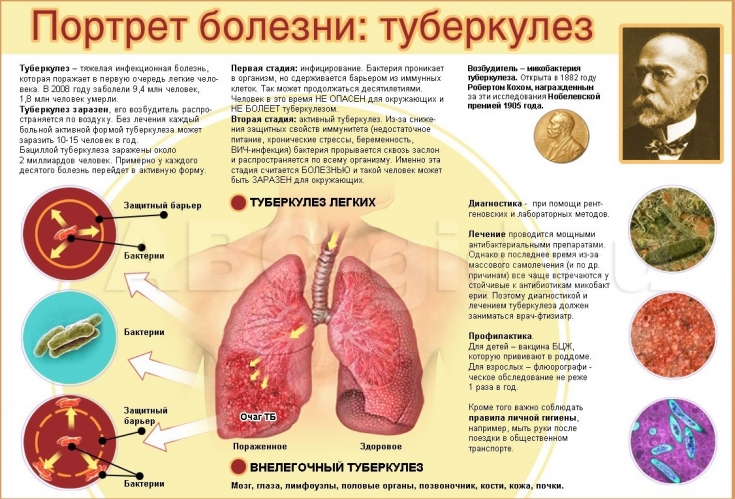Tuberculosis – dangerous disease, which is characterized by the likelihood of relapse. Even if you went to the doctor in time and cured him, then you should not relax.
This disease has a primary and secondary form. The latter appears in case of reactivation of the infection, that is, a relapse occurs.
What factors "contribute" to appearance of secondary tuberculosis and why it is dangerous – estet-portal.com will tell about it. You will learn about the forms of this disease, the symptoms and what treatment will help get rid of the problem.
Secondary TB it is important to detect it in time and contact specialists as soon as possible!
1. What is secondary tuberculosis
2. Secondary tuberculosis: forms and consequences
3. Secondary tuberculosis: treatment of different forms
What is secondary tuberculosis
Secondary tuberculosis occurs in people who have already had it before. That is, those who have already been infected before are at risk of getting sick. In this case, infection with another type of bacteria occurs or an exacerbation of remission occurs. Such a disease proceeds much more complicated than the primary form.
Recurrent tuberculosis can occur due to infection with Koch's bacillus through wounds, food or airborne droplets from the patient. The second path – reactivation of the focus of the disease due to a decrease in immunity and weakening of the body.
The risk of recurrence is increased by:
• the presence of chronic diseases;
• eating disorders;
• the presence of bad dependencies – alcoholism and drug addiction;
• smoking;
• immunosuppressants.
The state of the environment also negatively affects – unfavorable environmental conditions or potentially dangerous working conditions.
Primary TB does not give 100% immunity, so reappearance of the disease is quite possible.
Follow us on Instagram.
Secondary tuberculosis: forms and consequences
The secondary form of tuberculosis has several forms. All of them have a different degree of danger to others. But for the patient himself, they pose a clear threat. If treatment is not started on time, a milder form can develop into a dangerous one. Complications on internal organs are possible.
There are such forms of secondary tuberculosis:
1. Focal – appears after mycobacteria have entered the healed foci. It is quite difficult to diagnose, because it does not have characteristic symptoms. It can be diagnosed only with the help of fluorography. This form of tuberculosis is dangerous to others due to dense foci. However, a person can recover quickly if he turns to specialists in time.
2. Infiltrative – infiltrates form in the lungs, around which lymphocytes and leukocytes accumulate. Half of the cases of "return" tuberculosis falls on this form. This form is dangerous in that lung tissues are destroyed, cavities appear. It is also contagious to others. Characteristic symptoms: a sharp increase in temperature, hemoptysis, severe weakness.
3. Tuberculoma – a focus with curdled masses appears in the lungs, but the disease itself does not have characteristic symptoms. As the foci grow, a person notices weight loss, hyperthermia, bloody discharge from the lungs.
4. Caseous pneumonia – it can affect one lung or both. This is one of the most dangerous forms, because it has a high mortality rate – up to 80%. Cavities form in the lungs, they gradually die off. That is why even those who are cured often remain disabled for life.
5. Fibrous-cavernous tuberculosis – characterized by the appearance of cavities and fibrous capsules in the lungs. It manifests itself as weakness of the muscles of the thoracic region, intoxication, wheezing and coughing up blood. This form is treated, in most cases, surgically.
6. Cirrhotic tuberculosis – the volume of connective tissue increases. There is shortness of breath, cyanosis of the skin, the patient coughs up blood, suffers from sweating, weakness. The chest is deformed.
Any of these forms requires immediate medical intervention and treatment.
One of the most informative methods for diagnosing any form of tuberculosis is computed tomography.
Secondary tuberculosis: treatment of different forms
Secondary tuberculosis is treated exclusively in a hospital, because some of its forms are potentially dangerous to others. In addition, the treatment will be systemic. And it requires various procedures that are carried out only under the supervision of a doctor.
For treatment, mucolytic and expectorant drugs are used, inhalations, antibiotic therapy are used. Delayed treatment can lead to complications on other organs of the body.
Treatment of cavernous tuberculosis will take a long time, in some cases surgery is required. Tuberculoma is treated with chemotherapy, surgery is often needed – in especially neglected cases.
Secondary tuberculosis in each of the cases requires the patient to be admitted to a hospital. Further treatment will be combined. Its duration and complexity will depend on the form of the disease and the degree of its neglect.
If the secondary form of TB is not treated, there is a high chance of death.
Secondary tuberculosis is much more dangerous than the original form of this disease.
Many people believe that having been ill with tuberculosis, it is impossible to catch it a second time. But due to a number of factors, the disease can return. Bad habits, weakened immunity, unhealthy lifestyle, malnutrition contribute to this.
Therefore, the best prevention of tuberculosis – it is a healthy diet, smoking
are dangerous because they have a high percentage of adverse outcomes. To prevent this, hospitalization and comprehensive treatment are needed.
What is a "check-up" in medicine and to whom it is indicated
You may be interested in: Perfect belly in 5 minutes a day.







Add a comment